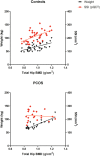Competing Factors Link to Bone Health in Polycystic Ovary Syndrome: Chronic Low-Grade Inflammation Takes a Toll
- PMID: 28611442
- PMCID: PMC5469792
- DOI: 10.1038/s41598-017-03685-x
Competing Factors Link to Bone Health in Polycystic Ovary Syndrome: Chronic Low-Grade Inflammation Takes a Toll
Abstract
Chronic inflammation predisposes to poor bone health. Women with polycystic ovary syndrome (PCOS) experience androgen excess, ovulatory disturbances, insulin resistance, abdominal adiposity and chronic inflammation. Our objective was to investigate the relationships among bone health parameters, chronic subclinical inflammation and anthropometric measures in premenopausal women with and without PCOS. In 61 premenopausal women, 22 women with PCOS and 39 controls, we assessed bone parameters (total hip bone mineral density [BMD] by dual-energy X-ray absorptiometry and radius strength-strain index [SSI] by peripheral quantitative computed tomography), inflammation (C-reactive protein/albumin), oxidative stress (leukocyte telomere length, urinary 8-hydroxydeoxyguanosine); hemoglobin A1c; anthropometric measures (body mass index, waist-to-height ratio, cross-sectional muscle area). A diagnosis of PCOS negatively predicted (beta = -0.251, p = 0.022) hip BMD in a regression model including weight. In women with PCOS, inflammation, which was predicted by increased waist-to-height ratio and current use of oral contraceptives, attenuated the positive influences of increased weight and muscle mass on bone strength and was inversely associated with radial SSI (R2 = 0.25, p = 0.018). In conclusion, chronic subclinical inflammation may negatively impact bone physiology in women with PCOS. Strategies focused on reducing abdominal adiposity and avoiding medications that increase inflammation may counter this effect.
Conflict of interest statement
The authors have no competing financial interests related to this study to declare. Unrelated to the contents of this study, S.K. holds the position of Director of Scientific Innovation at Qu Biologics (Vancouver-based biotechnology company).
Figures


References
Publication types
MeSH terms
Substances
Grants and funding
LinkOut - more resources
Full Text Sources
Other Literature Sources
Medical
Research Materials

